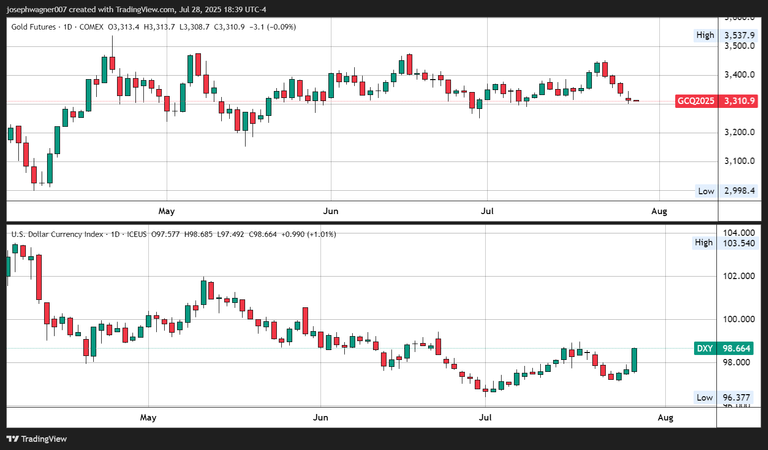Recent developments in international trade negotiations appear to have significantly influenced precious metals markets, contributing to gold's weaker opening and subsequent decline throughout the trading session. The precious metals complex responded to a confluence of trade-related news that strengthened the U.S. dollar and reduced demand for traditional safe-haven assets.
The primary catalyst for market movement emerged from progress on multiple trade fronts. The United States and European Union reached an agreement establishing a 15% tariff structure on EU imports to the U.S., providing clarity on a significant trade relationship. Simultaneously, Chinese media sources reported that the U.S. and China are likely to extend their existing tariff agreement by 90 days, offering temporary stability to the world's largest bilateral trade relationship. The Trump administration has indicated that countries without negotiated trade agreements will soon face assigned tariff structures, suggesting a comprehensive approach to trade policy implementation.
These positive trade developments generated the most substantial single-day dollar appreciation since April, with the ICE U.S. Dollar Index surging just over one percent to reach daily highs of 98.66. The dollar's strength was further supported by monetary policy expectations, as the Federal Reserve's upcoming meeting shows minimal probability of rate reduction. According to the FedWatch tool, market participants assign only a 3.1% probability to a rate cut, with 96.9% expecting rates to remain unchanged. The absence of a Federal Open Market Committee meeting in August suggests that the current elevated interest rate environment will persist at least until September's scheduled meeting.

Despite the dollar's pronounced strength, gold demonstrated some underlying resilience. While gold futures declined $24.50 to close at $3,314, representing a 0.73% decrease, this decline was notably modest relative to the dollar's appreciation of over one percent. This divergence suggests the presence of strategic buyers willing to accumulate gold positions despite the challenging technical environment created by dollar strength.
Silver markets exhibited a more complex response, reflecting the metal's dual industrial and monetary characteristics. The positive economic implications of the EU-U.S. trade agreement benefited silver's industrial demand component, as improved trade relations typically support manufacturing activity and industrial metal consumption. Conversely, the same trade progress that boosted industrial demand simultaneously reduced demand for silver's safe-haven properties. These opposing forces essentially canceled each other out, resulting in silver futures closing nearly unchanged, down just half a cent at $38.33.
For those that would like more information about our services click here
Wishing you as always good trading,

